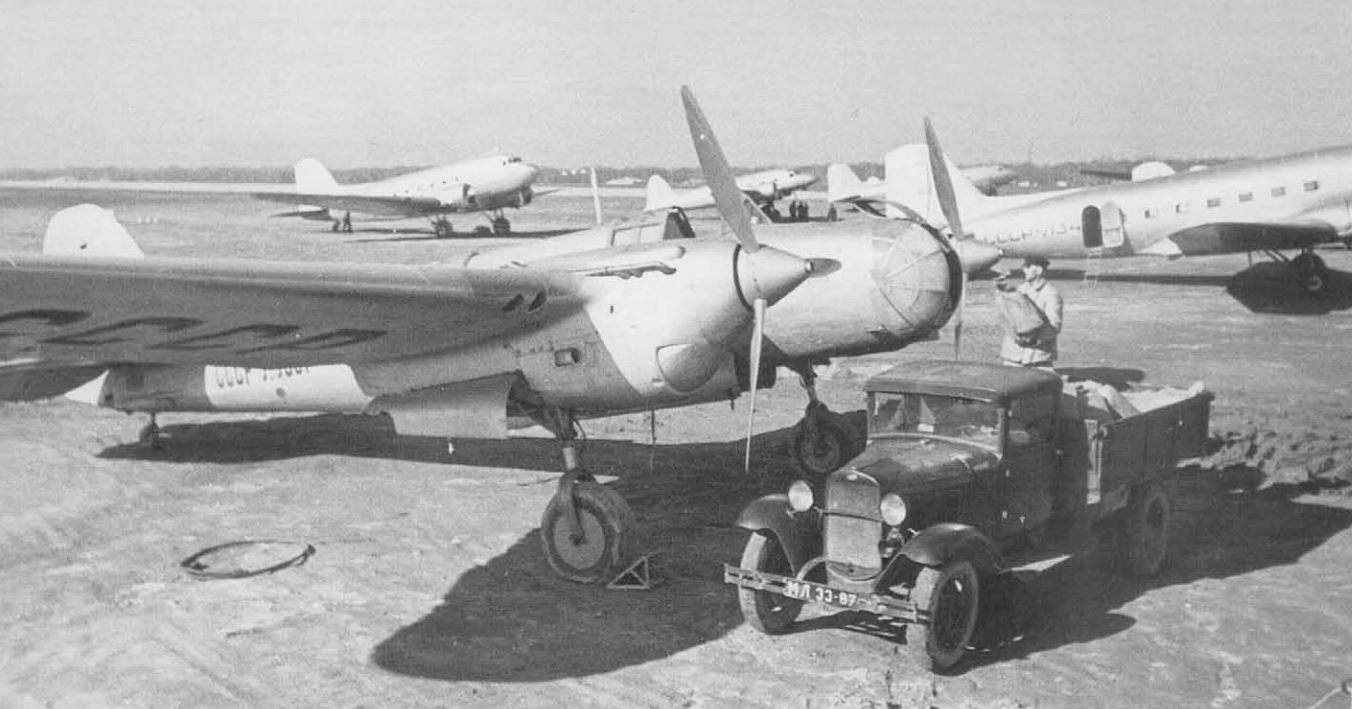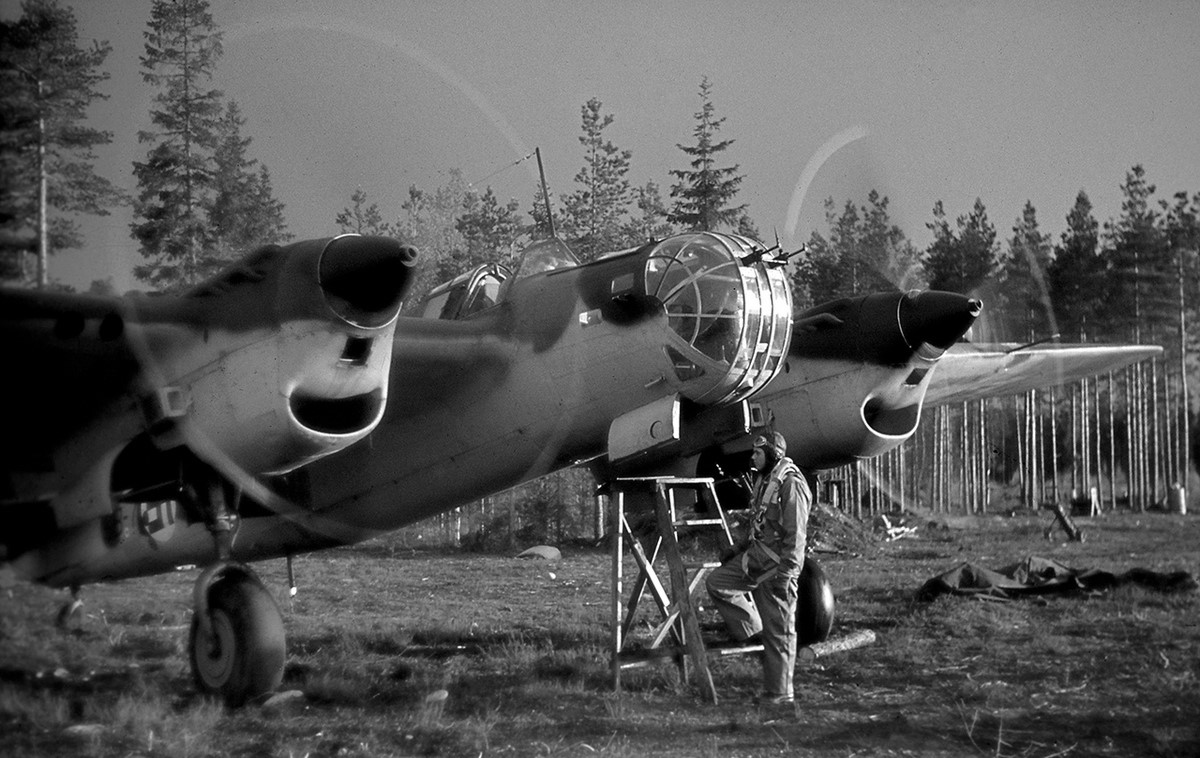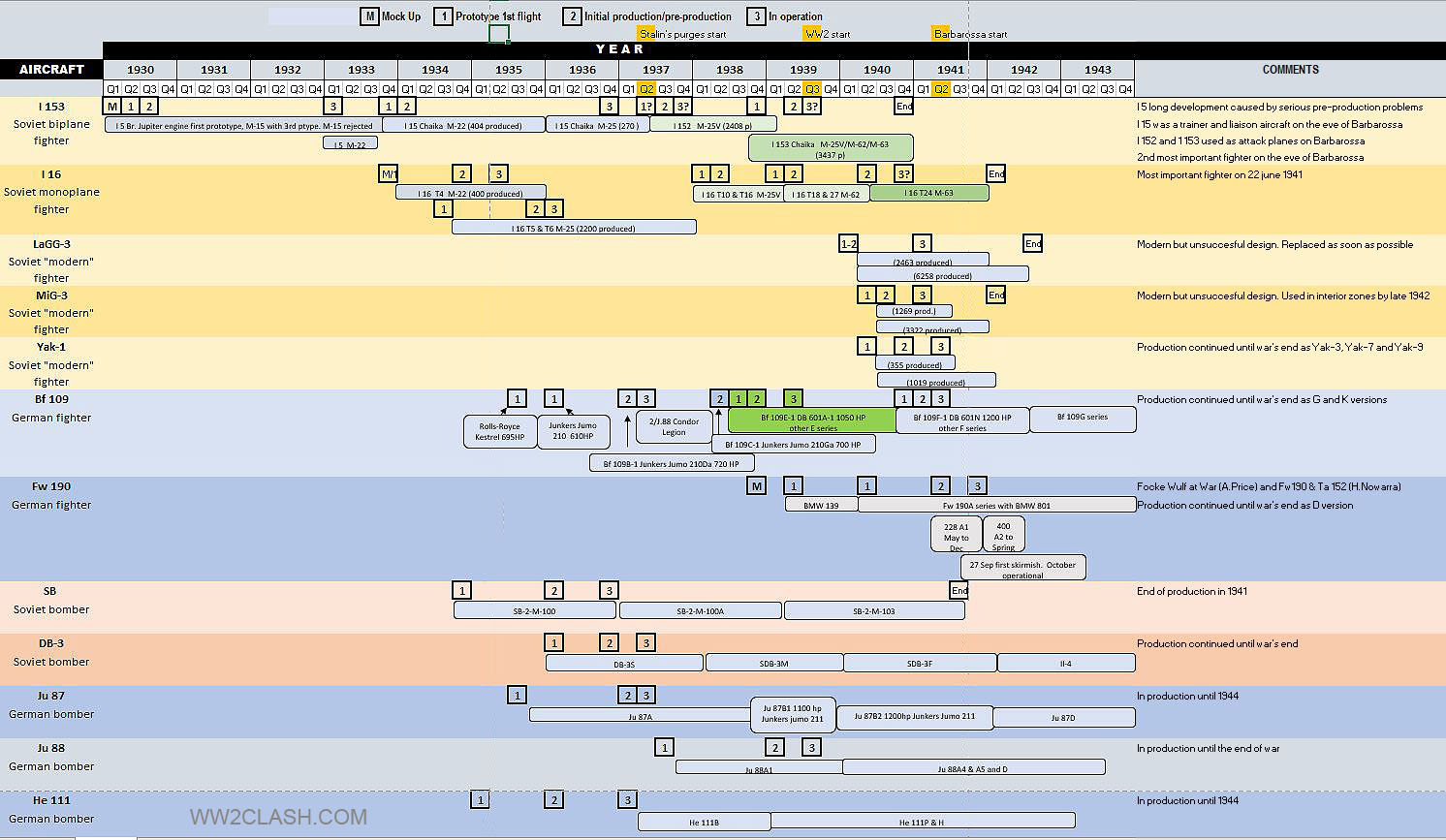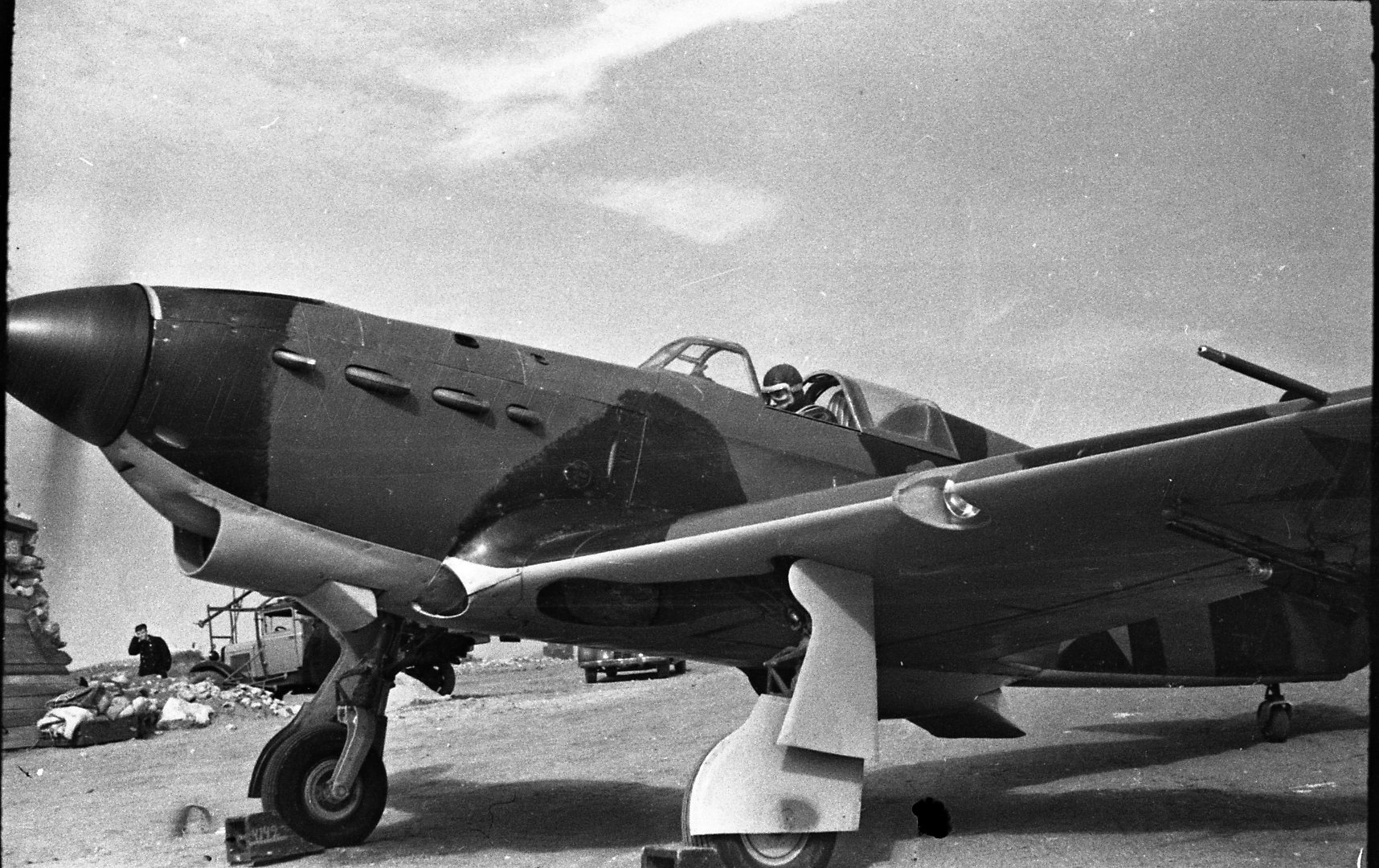


When the Luftwaffe was born in 1935 the Soviet Air Force had been growing and modernizing for almost a decade. Starting in 1933, imported American machine tools and technology, helped expedite aeronautical development in the USSR so that for a brief moment, in early 1936, the VVS was the most advanced and innovative air force in the world.
At the time, it could lay claim in possessing the best fighter and bomber aircraft in service in any air force. Polikarpov’s I-16 became the first produced monoplane fighter with retractable landing gear. Tupolev SB bombers flew faster than the Nationalist fighters it faced over Spain that year.
This outstanding result proved unsustainable because during the early-thirties to the mid-forties aviation technology advanced by leaps and bounds worldwide while the technological foundations of the Soviet Union aeronautical industry remained too narrow. The Russians embarked on titanic efforts to overcome the gaps, but they were only partially successful.
Consequently, only a year later, with the introduction of the German Messerschmitt Bf 109B over Spanish skies in the spring of 1937 the momentary advantage was lost. It must be emphasized that this was only 2 years after the creation of the Luftwaffe.
The forceful expansion of the Soviet aeronautical industry revealed many critical bottlenecks that remained unsolved on the eve of Barbarossa. Modern aircraft construction demanded aluminum airframes, but the light-alloy industry lacked the capacity to produce this metal in sufficient quantities. The aluminum production of the USSR stood at one-third of Germany’s capacity in 1939, 60.000 tons vs 190.000, and even though output increased to 100.000 tons by 1941, the adverse ratio remained unchanged (Germany produced 324.000 tons that year) . This forced Soviet designers to use wood as a substitute. The strength of wood is one-third that of aluminum, although it weighs one-third as much as well. Wooden airframes, as a rule, carry with them a small weight penalty compared with an equivalent aluminum structure and this translates into lesser performance, everything else being equal.
The development of more powerful engines prompts the introduction of newer higher performance aircraft models. The aero-engine industry initially depended fully on copies of foreign designs and the need to modify these designs after their earlier introduction by other nations meant that the USSR was behind in the race for motors with higher power-to-weight ratios. The new I-16, introduced in early 1936, made use of the M-25 radial engine, a copy of the American 630-HP Wright Cyclone SGR-1820 F-3 purchased originally in 1933 but whose copy turned more difficult than planned. It only became available in large quantities until the last months of 1935 .
When the Germans introduced the 720-HP Junkers Jumo 210Da powering the Bf 109B in 1937, they leap-frogged the Soviets. It took the Russians until early 1938 to improve the M-25 into the 775 HP M-25V by which time the Germans were about to introduce the 1050 HP Daimler Benz 601A. The petrochemical industry displayed important gaps as well. First, it produced lower quality fuels and little TEL (tetra-ethyl lead, an anti-knocker compound) so the octane rating of the engines was slightly lower than the German’s. This lower octane rating meant that the pressure inside the cylinders at the start of the power stroke was reduced as compared to a higher-octane engine, generating less power as well. The combined effect of using mixed wood-and-metal airframes with lower power-to-weight index engines translated into lower overall performance of the aircraft which by necessity forced the use of lighter armament and payloads (i.e. bombs) to economize on weight and keep performance within reasonable limits. The petrochemical industry caused other problems as well, notably the production of low-quality Perspex which became rather opaque after a short exposition to sunlight . To overcome this, VVS fighter pilots inevitably operated their aircraft with open cockpits to detect the enemy, but the increased drag reduced the performance of their machines even further . In addition, the increased noise in the open cockpit negatively affected radio-communications.
The inferior technology level of the electronics industry had detrimental effects on the radio and radar industries. In the first case, it became impossible to equip Soviet fighters with transceivers (radio transmitter and receivers), except for squadron leaders . During air combat, the priority is to detect the enemy and then communicate the enemy position to the leader so he can maneuver the formation into a favorable position for attack. Detection depended on eyesight, and although Russian and German eyes had similar performance, the lack of transmitters implied that the typical Soviet pilot was unable to communicate with his squadron leader as effectively as his German counterpart, giving the Jagdwaffe a crucial tactical advantage as air combat occurred within seconds of detection.
In the second case, the lack of powerful and accurate radars caused the Soviet airspace to be porous and prevented an adequate concentration of force on critical locations when on defense, a problem infrequently faced by the German, who operated portable Würzburg radar sets.
The manufacturing industry, under Andrei Shakhurin, performed much more efficiently than its German equivalent in terms of output, but in terms of quality, it left a lot to be desired. The low-skilled labor produced up to 50% of defective parts and the aircraft subsystems (hydraulics, radios, magnetos, etc.) were notoriously unreliable causing accidents and lack of confidence in pilots. This undependability reduced aggressiveness because the flyer needs an aircraft that he can count on when he is risking his life.
The Communists endeavored greatly to eliminate the technological and industrial deficiencies inherited from the previous regime, but they found it impossible to completely close the gaps. The VVS would face the Luftwaffe from a position of relative inferiority. It must be said, however, that Stalin’s achievements were considerable. The Soviet air force compared favorably with almost any other major foreign air force in 1941, including those of the United States, Japan, Italy, and France (as it was in 1940). Only the RAF boasted a higher level of preparedness than the Soviet air force.
Regrettably for Russia, Luftwaffe’s achievements were monumental. German industry was more advanced than the Soviet’s, to begin with, but still, the Germans surpassed militarily the Soviets even though the latter enjoyed a head-start twice as long. On the other hand, the communist regime was fully responsible for the operational decisions made regarding the use of the tools they produced. These decisions magnified the inferiority of their air force.
In the summer of 1937 while Stalin’s purges were gathering steam, and despite the recent introduction of the Bf 109B in Spain, a meeting to delineate future fighter development resulted in the conclusion to continue the improvement of biplane fighters. The Russians based this decision on the difficulties the monoplane I-16 faced battling the Italian Fiat CR.32 biplane fighter who utilized sharp turning tactics in combat . Moscow earmarked significant resources and manufacturing capacity to this venture which, time would prove, was mistaken. By 1941, the biplane I-153 (equipped with retractable landing gear) who entered operational service months before WW2 started, was the second most important fighter in the VVS inventory but its achievements were not commensurate with their numbers . It had a silver lining, however. It allowed the instruction of scores of factory workers and the training of a high number of pilots in reliable aircraft.
Less than a year later, in the spring of 1938 and in the thick of Stalin’s purges, another meeting took place with the same objective. By that time a Bf 109B had been captured and thoroughly evaluated. The Russians gave praise to their designs and scorned the German fighter. It would be highly speculative to claim that this stance may have been caused by the fear of being sent to a gulag if admission was made of the inferiority of Russian designs at a time when the Soviet state was committing huge amounts of money to the aeronautical industry, but it is a possibility. On the other hand, it is true that with the advent of the M-25V to equip the imminent introduction of the I-16 Type 10, this aircraft would appear better than the Bf109B in almost every parameter. The Russians decided that there was no urgency to introduce new fighters. Prudently thought, they set in motion activities to both, develop existing models and to introduce completely new types with even more powerful engines. They also agreed to create new design bureaus to foster competitiveness and accelerate aircraft developments.
Months later, in January 1939 while the drums of a new European war were plain to hear, another meeting presided by Stalin took place. By this time, it was clear that the development of the biplane fighter was in error, that the new models of the Bf 109 were superior to the newest I-16s and that the USSR did not have any new fighter ready for large scale production. Stalin, concerned with this turn of events, demanded the speedy development of new high-performance fighters even if it meant cutting corners. He dispensed top priority to the most promising design proposals of departments led by A. Yakovlev, S. Lavochkin, and A. Mikoyan & M. Gurevich .
From these bureaus, the Yak-1, LaGG-3, and MiG-3 respectively, emerged in full-scale production and deployed to operational units in record time. The total aircraft of the three modern fighters in frontal units amounted to 980 fighters on 22 June 1941. This number exceeded the 912 Bf 109 interceptors the Germans deployed (70% of which were the latest F models and the rest older E models, including 38 in fighter bomber units). From prototype first-flight, it took less than 12 months for each of the new Soviet fighters to arrive at operational units! To put this feat in perspective, the German Focke Wulf Fw 190 required slightly more than 2 years or twice as much time, and it was not introduced in Russia until the next year because of technical problems.

Unfortunately, the Soviet design bureaus achieved this exceptionally rapid introduction by cutting too many corners. All of the newest fighters were on paper a match to the Bf 109, but in reality, they all exhibited teething problems that caused very difficult introduction into service, demoralizing the fighter pilots who found their aircraft prone to accidents and challenging to handle . The LaGG-3 and MiG-3 proved inferior in combat and production ceased by mid-1942. Notwithstanding its immaturity, the Yak-1 attested its potential and with improvements, it continued in operation until the summer of 1943. This fighter’s progeny (in the form of the Yak-3 and Yak-9) would continue in production until the war’s end and eventually represented 58% of all WW2 fighters produced by the USSR .Despite the failure of the inline LaGG-3, a version with a new radial engine that appeared in 1942 as La-5 would prove ultimately successful.
For the Barbarossa period, none of the Russian newest fighters proved a match for the Bf 109F in the crucible of combat, but neither they nor even the I-16, were the sitting ducks some authors portray. We can find Soviet fighter pilots who became aces with every model.

To the faulty decisions concerning fighter development, ill-defined aerial operational doctrine must be added. There were three operational principles where the VVS differed significantly from Luftwaffe practice and events would demonstrate their inadequacy.
The German air force determined that the best way to achieve operationally decisive outcomes consisted in concentrating overpowering force in critical breakthrough corridors to the expense of non-critical sectors. Once the Army High Command selected the main axes of advance and earmarked a panzer army (Panzergruppe) to each, the Luftwaffe would assign a complete Fliegerkorps to support every such drive. The Fliegerkorps was the minimal concentration of force deemed necessary to achieve operationally important results. A Luftflotte headquarters would monitor performance and designate high-level objectives and resource allocation among its Fliegerkorps according to changing conditions.
A Luftflotte (along with its Fliegerkorps) commanded all bomber, fighter, and transport flying formations (plus some observation squadrons assigned to operational reconnaissance missions) within a large sector (the size of an army group).
The only flying units that were decentralized and not under command from the Luftflotten were the reconnaissance Staffeln assigned to army corps and panzer divisions.
In contrast, the VVS divided its forces into four large groupings: 13.5% of combat aircraft to Supreme Command (including PVO –fighters protecting critical areas-, and DBA –long-range bomber aviation-), 40.5% to Front Commands, 43.7% to Army Commands, and 2.3% to Corps Commands . This dispersion barred the speedy concentration of force and was a hindrance to effective multi-mission operations that entailed fighter-bomber-reconnaissance synchronization.
Some of this dispersion was logical, specifically, the observation aircraft controlled by corps (similar to the Luftwaffe decentralization of these aircraft to the army) and the PVO controlled aircraft since fighters located far in the rear to protect essential industrial or urban targets were impossible to control from the front.
The long-range aviation dispersal is questionable. Initially, the intention was probably to allocate strategic objectives to this force different from those in the battlefront, and under this assumption, the organization made sense. But in practice, over 94% of the missions carried out by the DBA during the war were tactical . The result was that target designation proved difficult to coordinate with far-away Front Commands and equally important, fighter escort could not be suitably harmonized. Most of the missions flown by the DBA between 22 June and 3 July were tactical and without fighter escort which caused so severe an attrition that on the latter date they were abandoned, and the bombers reverted to night bombing .
The split of 84% of air assets between Front and Army Commands in about equal quantities is exactly what the Luftwaffe organization avoided with better results. In the end, the tempo of operations that the VVS could achieve was inferior to the Luftwaffe’s as well as the momentum (rapidity with which a powerful force can be concentrated in a critical sector).
The force structure of the air force must also reflect the missions deemed essential to achieve the support desired by the high-level commands. The Luftwaffe force structure for Barbarossa was fined tuned to the type and number of missions envisioned: 40% bombers, 30% fighters, 20% observation, and 10% transportation. If an air force has only fighters, they could probably dominate the air space earmarked for protection, but they cannot hit enemy surface targets, or observe the enemy’s ground movements, or support the logistics formations to smooth the advance. Many fighters would find themselves under-utilized.
If no fighters are available, bombers and reconnaissance aircraft would face hazardous airspace that would turn their missions costly. A proper balance must be struck, and the Luftwaffe ratios above reflect this balance.
The VVS balanced its air force differently: 50% fighters, 38% bombers, 7% observation, 6% transportation. The VVS gave much more importance to fighters than bombers, and much less importance to observation as compared with the Luftwaffe.
Target allocation is driven by the ability to detect the targets in the first place. The proportion of 1 observation aircraft per every 2 bombers in the German air force indicates the importance given to this mission. This ratio allowed the Luftwaffe to gather the necessary intelligence to identify and subsequently hit the targets deemed most important in a fluid scenario. The Soviet observation ratio was only 1 reconnaissance aircraft per every 6 bombers.
The high number of fighters relative to bombers is enlightening as well. Why did the VVS deploy 5 fighters per every 4 bombers while the Germans managed with only 3? The Germans considered that 3 were sufficient to control the airspace and any aircraft after that would be more productive punching at enemy surface targets. The high number of fighters the Russians threw to the battle did not translate into air superiority, however. They proved difficult to coordinate due to improper command and control networks, which coupled with the relative inferiority of the fighter designs and their tactics, translated into a loss of efficacy.
Finally, the air missions themselves seem badly envisioned, in particular, bombing operations. Many authors insist that the VVS bomber fleet failed to dent the German offensive, despite large numbers, because of obsolescence. But this hypothesis is likely wrong.
The SB and the DB-3 made up the bulk of the VVS bomber force on 22 June 1941. The first was a light, fast twin-engine bomber whose latest variant, the SB 2-M-103 appeared in 1939. The second was a long-range horizontal bomber, whose most recent type, the DB-3F, first emerged in 1940 .
All of the bomber aircraft of the period started prototype testing within two years of each other. The latest variants of all of them appeared within the same time range. The performance of the SB-2-M-103 light bomber stood as competitive when comparing it with other light bombers of the time, like the Junkers Ju 87B-2 and the British Bristol Blenheim Mark IV. It was faster, carried a larger bomb load and had a better operational ceiling. Its range, while inferior to the British bomber was much better than the German one. All were equally vulnerable against fighters due to their light defensive armament.
The DB-3F medium bomber could carry a heavier bombload or attack a more distant target than the Heinkel He 111H-6. It had a higher operational ceiling and could fly 97% as fast.
To achieve these excellent characteristics, the designers had to substantially reduce the weight of the aircraft by minimizing defensive armament and therefore it compared unfavorably with the German bomber in this category. The Heinkel He 111, however, remained vulnerable to fighter attacks as attested by the recent experience in the Battle of Britain.
The fundamental reason behind the inferior capability of the Soviet striking force lies in the lower accuracy to hit the small targets that comprise the bulk of valuable objectives in the zones of operations.
Of the almost 4.000 Soviet bombers, only the 129 Il-2 low-level strikers and the 238 Pe-2 dive bombers had the accuracy to hit them hard. This is only 10% of the bombing force. The other 90% used the much less accurate method of horizontal bombing from medium altitudes.
In contrast, 77% of the Luftwaffe bomber force could deliver highly accurate dive-bombing and low-altitude horizontal attacks. The rest of its bombers could concentrate on larger sized targets.
The inferior target designation process (partially caused by the less dense observation aircraft force) and a more hazardous operational environment due to more intensive enemy flak and fighter interception, coupled with the much lower bombing accuracy had a significant impact in reducing the efficacy of the VVS bomber force.
The German fighters shot down scores of enemy bombers aided by the timely detection of the Luftflotten detection networks. Soviet bombers preferred to attack from medium altitudes (over 10.000 feet), to minimize the danger posed by fierce light flak at lower altitudes, but this made them conspicuous. The Bf 109s could obstruct the enemy blows quite effectively aided by the lack of escorting enemy fighters and the propensity of VVS bombers to fly stubbornly in a straight line without evasive maneuvering. Furthermore, the firepower of the German fighters evidenced ample capability to destroy the unarmored lightly defended Soviet bombers.
Within days the Russians realized their predicament and increased the production of the Pe-2 and Il-2 bombers while stopping the manufacture of the SB altogether. This change in force composition (emphasis in low-level and dive-bombing) had less to do with the protection of the bombers (speeds and defensive armament were similar, although the Il-2 was much better armored) than with the increase of bombing accuracy and stealth: the new Soviet bombing tactics incorporated low-altitude approaches to reduce detectability and low-level horizontal and dive-bombing to increase precision, imitating to some extent, the Luftwaffe methods . The DB-3F, continued in production but it changed its tactics to the inexact, but safer, night bombing method.
